Studio Ghibli: A beginner's guide through the worlds of Spirited Away, Mononoke, and beyond
In 1986, one year after its founding, the creatives at Studio Ghibli unveiled their first film. Castle in the Sky, written and directed by the prolific Hayao Miyazaki, brought to screens a charming tale of fantasy, drama, and growing pains, setting the stage for what this dynastic Japanese animation house would craft in the decades to come. Since that day, audiences all over the world have felt the deep impact of these stories and their influence on animation, but now Studio Ghibli has an even broader reach. For the first time since its founding, their films are now available to be purchased digitally, works like Spirited Away, Princess Mononoke, Kiki’s Delivery Service, and, yes, that first feature that started it all. Ghibli has largely been associated with Miyazaki’s work but also highlights other animators and filmmakers. Through tales about a wolf princess, a bathhouse for spirits, moving castles, a friendly witch, and friendlier creatures of the forest, these films capture the human experience in all its forms. All beginners need guides, especially through such fantastical vistas. So, let’s begin.
Where to start
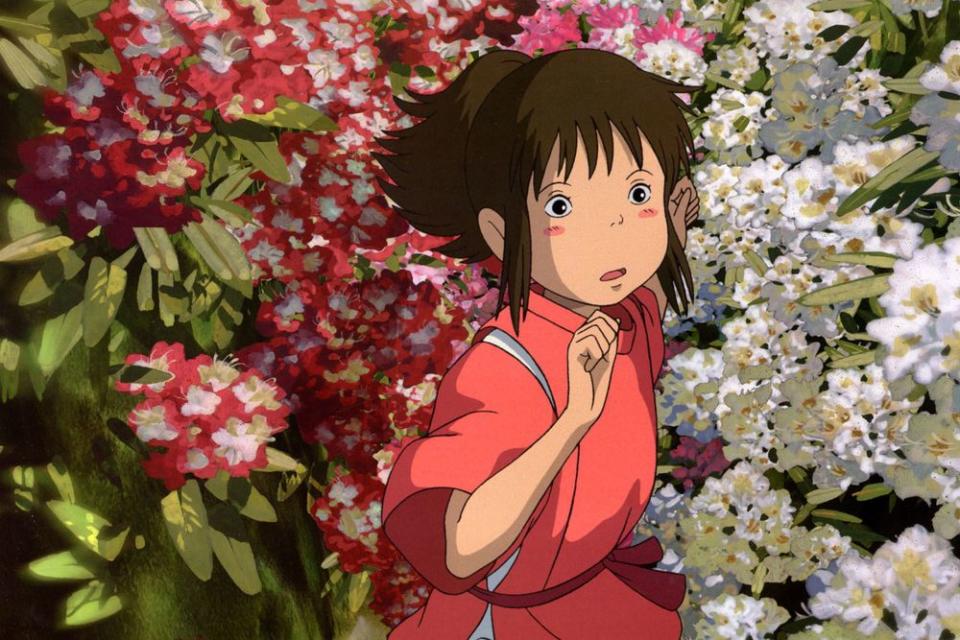
Spirited Away is as synonymous with Ghibli as Miyazaki himself. It may not be his best work, depending on which Miyazaki altar you choose to worship at, but it’s certainly the most well known. Mainstream acclaim came through the title’s best-animated film win at the Oscars in 2003 and the constant praise from John Lasseter, who headed Pixar at the time. It’s a film that’s as equally spirited, if you will, as it is awe-inspiring, poignant, and honest. Chihiro, a 10-year-old girl, is in the backseat of her parents’ car, not-so-quietly holding in her anxieties as they make their way to their new home. (Miyazaki tells many of his stories through the lens of women and young girls facing the world — or worlds.) Along the way, they stop at what appears to be an abandoned carnival, but as soon as her mom and dad taste the food, they transform into pigs and the realm of spirits folds in around her. Finding herself in a bathhouse that caters to spirits, Chihiro meets Haku, a mysterious apprentice to the witch Yubaba, who runs the resort. He tells Chihiro to get a job here until they can find a way to save her parents and return to the mortal world. It’s a story that explores many of the same themes found throughout Miyazaki’s Ghibli works: nature, the resilience of children, facing fears, embracing change, and the pangs of growing up. It’s both a summation of Ghibli’s aesthetics and the spectrum of the studio: a story about kids and for kids that contains beauty and frights. —Nick Romano
So, where do you go from here? There are a few options.
The kid-friendly
These films never underestimate children. Even the more G-rated offerings celebrate their imaginations, tenacity, and brilliance, providing complex characters who undergo dramatic internal changes on their journeys.
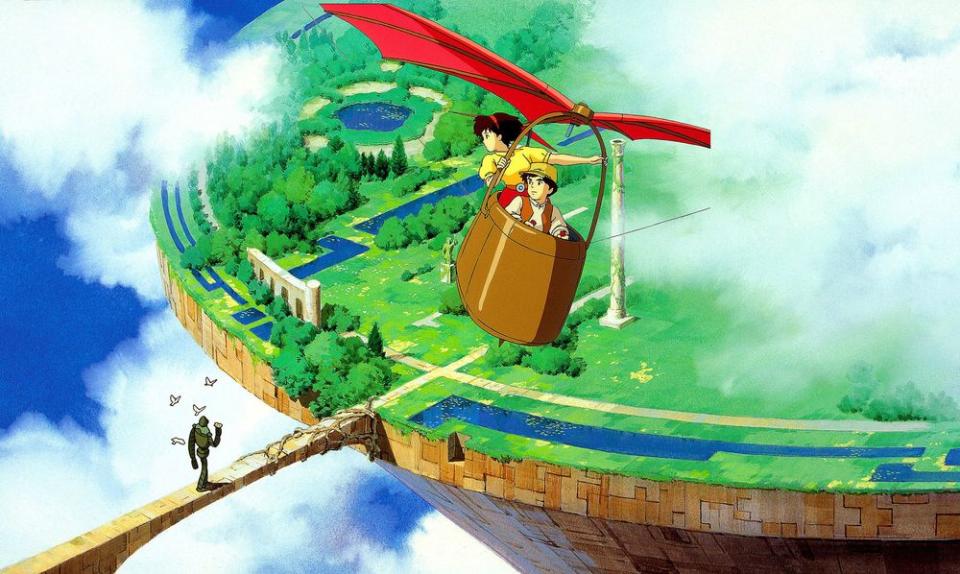
Castle in the Sky (1986)
The cultural influence of Studio Ghibli’s first film is hard to overstate, but Castle in the Sky also remains an enchanting a watch. The film begins with a young girl falling from the sky, saved only by her magical necklace that keeps her afloat. She’s found by a bright-eyed young boy named Pazu, whose late father once glimpsed an impossible castle floating amidst the clouds called Laputa. When it becomes clear that the girl Sheeta has a deep connection to Laputa, the two embark on the journey of a lifetime — though they must contend with those who seek Laputa’s long-lost resources for nefarious ends. One of Miyazaki’s great themes is the struggle between man-made technology and the natural world, and Castle in the Sky is a fascinating iteration of that tug-of-war. Industrial society is natural to Pazu; he bounds around the iron railings and factory edifices as easily as some boys climb trees, and Miyazaki (heavily influenced by his experience in Wales witnessing the 1984 miners’ strike) depicts the community of industrial miners with love. The great robot guardians of Laputa are a wonder that inspired countless steampunk stories, but many of them succumb to the passage of time and plant overgrowth. Laputa, the height of human scientific achievement, proves to be a hollow paradise compared to the wonders of the natural world. —Christian Holub
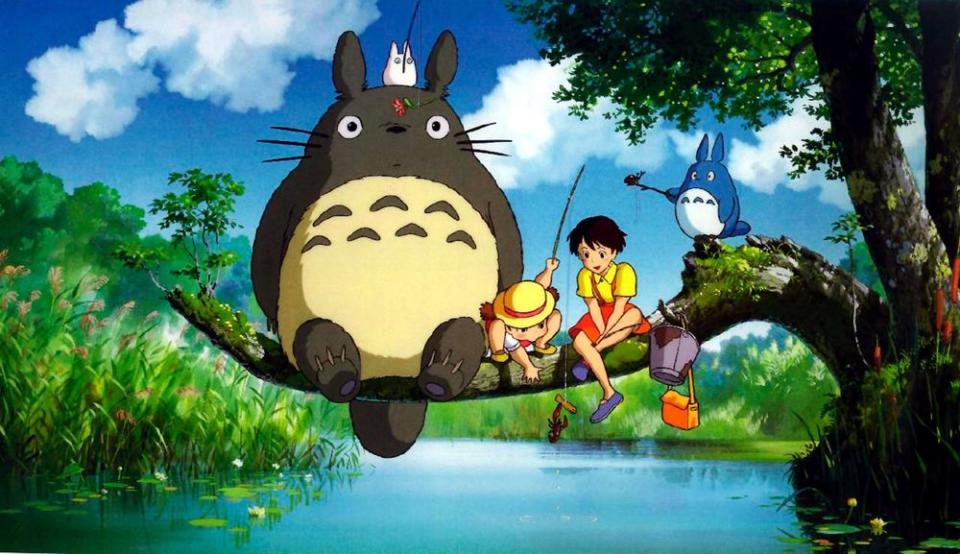
My Neighbor Totoro (1988)
With My Neighbor Totoro, featuring the titular jolly nature spirit, Miyazaki and Studio Ghibli set out to create a film that would make people happy and stoke their imaginations. They also wanted to make something that would proudly show Japan’s beauty. Hence the lush animation. Two sisters, Satsuki and Mei, move to the outskirts of their town while waiting for their mother to recover from her stay in the hospital. Their mom is forced to stay longer and longer, but as sadness grows within the children, they are distracted by the discovery of Totoro. This is what they call the spirits of the forest who usually go about unseen by humans. It’s a love letter of sorts to that time when children play around giant oak trees, envisioning them as portals to other worlds; a time exploring the nooks and crannies to see what creatures might live in those hidden crawlspaces. —NR

Kiki’s Delivery Service (1989)
There’s a feeling of whimsy in the concept of 13-year-old Kiki, a young sorceress who, as part of her training, must live in a strange town and work to get its inhabitants to consider her a full-fledged witch. She has a black cat, a radio from her father, and her mother’s broom. With flying as her only real trade skill, she starts her own delivery service, whisking messages and packages all over. But this also comes with a dose of reality; like parents who coat their children’s veggies in cheese, there’s something hidden within the playful imagery. Kiki’s Delivery Service explores loneliness and isolation, the fear of setting out on one’s own, and making a mark on the world. Because this is inherently a story about a girl, it’s also about breaking barriers and achieving both societal and spiritual independence. Kiki still influences films to this day; Mary and the Witch’s Flower, a movie from Studio Ponoc, founded by a few veterans of Ghibli, bears many similar animation flourishes to this magical work. —NR
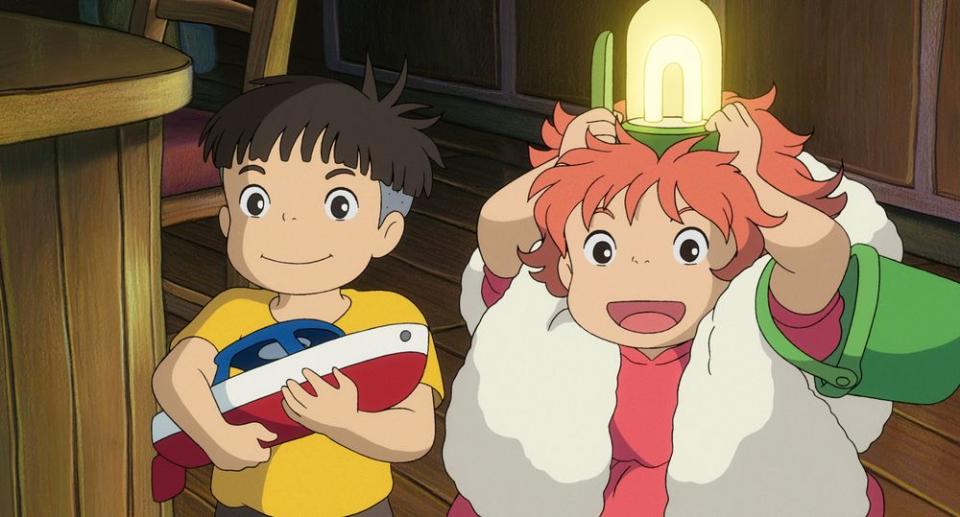
Ponyo (2008)
A unique twist on The Little Mermaid, Ponyo focuses on a goldfish girl who falls in love with a boy named Sōsuke. The laws of nature are in their way, however, and storms of fantastical proportions buffet Sōsuke’s seaside home as he and Ponyo try to find their way back to each other. Though smaller in scale than other films on this list, and much more focused on the sea rather than the sky, Ponyo nevertheless imbues its story of young love with fairy-tale magic. —CH
The wild and raging
A sentient humanoid pig, a ferocious boar god slowly eaten away from the demon chewing its way out, a wizard consumed by his loneliness and magic until he risks becoming nothing more than a hideous monster. These creatures exist on the other end of the Studio Ghibli spectrum, far away from the childlike light of their other projects. There are oddities and a sense of raw rage at what humanity has done to the world that Miyazaki isn’t afraid to explore.
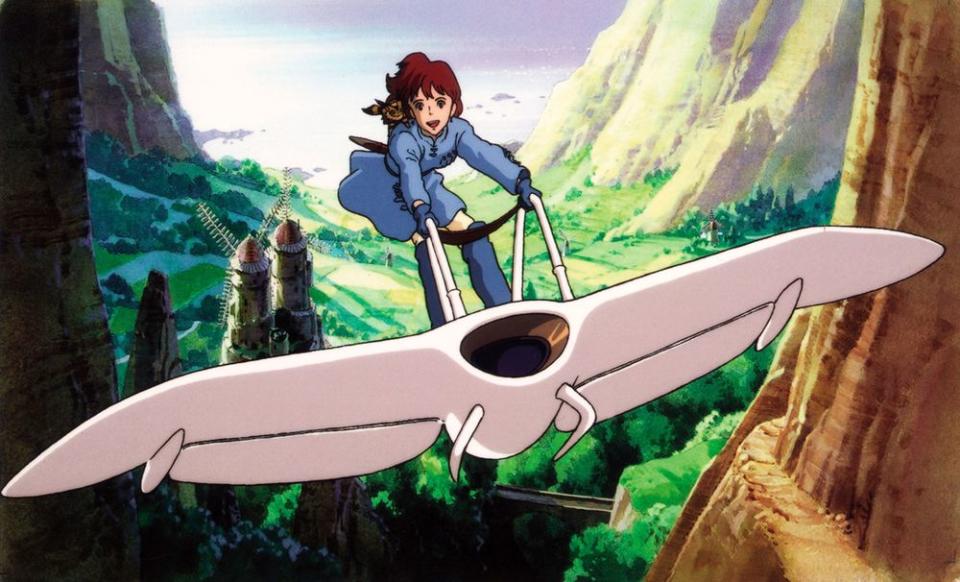
Nausicaä of the Valley of the Wind (1984)
Before the founding of Studio Ghibli, Miyazaki spent years developing a film based on the manga Nausicaä of the Valley of the Wind. Released in 1984, before the official founding of Ghibli, it’s still considered a Ghibli work and was released years later in collections of the studio’s films. “I was extremely irritated at the time,” Miyazaki once said of its creation. “I confess I was angry by the general state of the world, among other things.… In addition to being upset about environmental problems, I was also concerned about where humanity was headed, and especially about the state of Japan. Most of all, I suspect, I was angered by the state of my own self.” Miyazaki unpacks these thoughts in a futuristic setting, years after a war left civilization in ruins and the planet largely poisonous. Humans are trying to destroy the toxic jungle and the mutant insect inhabitants — the ones that spawned as a result of the war — but Princess Nausicaä, who can commune with these creatures, fights for a more harmonious future for them all. Miyazaki mused so Greta could rage. —NR

Porco Rosso (1992)
Unlike most Miyazaki films, Porco Rosso is really only one step removed from our own reality — but it’s a very large step. Set in Italy between the World Wars, Porco Rosso’s protagonist is a former flying ace who now hunts pirates in the Adriatic Sea. That’s more real-life historical and geographical context than most films on this list, but of course, there is a magical catch: Marco has been transformed into an anthropomorphic pig. But he didn’t succumb to greed like the parents of Spirited Away. Marco seems to believe he’s cursed for being a coward, or maybe just a survivor, but the only explanation we get is a mostly silent flashback to the war when Marco saw his friends die and briefly came face-to-face with eternity. That transcendent scene is one of Miyazaki’s most beautiful accomplishments. The rest of the movie has high-flying adventure, deeply affecting romance, and one of the greatest lines of movie dialogue ever: “I’d rather be a pig than a fascist.” —CH

Princess Mononoke (1997)
“Disgusting little creatures. Soon you will feel my hate, and suffer as I have suffered.” Princess Mononoke almost certainly has the bleakest opening of any Miyazaki film, with a rural village attacked by a rampaging monster. After the heroic Ashitaka manages to save his people and slay the monster, its true form is revealed: It was just a noble boar spirit who had been corrupted by the poison of man-made iron and industry. Miyazaki’s films typically showcase a love of nature, industry, or both, but in this film, they go head-to-head with violent and tragic results. Cursed by the boar, Ashitaka learns that the only possible cure for him is to find the great Forest Spirit. But like everything in Princess Mononoke, the Forest Spirit is two-sided: By day it is a silent stag with the power to heal, but by night it becomes an abyssal giant of destruction. Ideally, the nearby factory town would stop encroaching on the Forest Spirit’s sacred territory, but the settlement itself is a radical feminist experiment run by women. The world is changing, but what if there was a way to aid and embrace that change without inspiring hatred and cruelty? That is the question Princess Mononoke asks of everyone. —CH
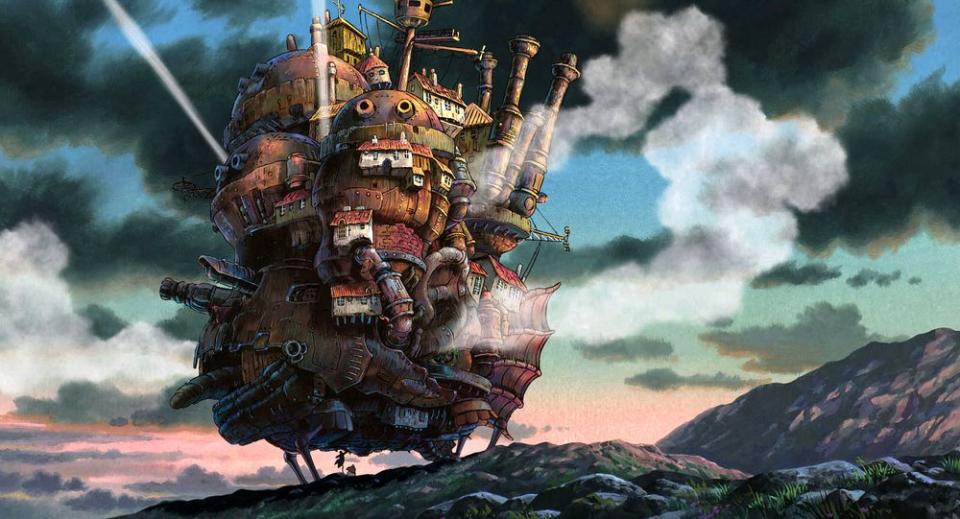
Howl’s Moving Castle (2004)
After Laputa, the next most important castle in Miyazaki’s oeuvre is the one a wizard named Howl built as a fortress of solitude. One of Miyazaki’s few adapted works (loosely based on Diana Wynne Jones’ 1986 novel of the same name), Howl’s Moving Castle was certainly the weirdest romantic comedy of the 2000s. A young girl named Sophie falls for a dashing wizard named Howl and is punished for it by a rival witch who transforms her into an old woman. At first, this has the makings of tragedy or body horror, but Sophie grows to love her new form and finds freedom in old age. While many Miyazaki films celebrate the magical innocence of youth, Howl’s Moving Castle finds something to treasure in aged wisdom. The United States’ invasion of Iraq formed the real-life backdrop to Howl’s Moving Castle. Summoned to war by his king, Howl can only look with disdain on wizards who eagerly turn themselves into monsters to fight someone else’s conflict. “Those wizards are going to regret doing that. They’ll never change back into humans,” Howl’s fire-demon familiar Calcifer says mournfully — a lesson for all the real-life artists and thinkers who eagerly supported that war and others. —CH
Non-Miyazaki

The full scope of Studio Ghibli goes beyond Miyazaki, though his sheer force as a storyteller continues to define its legacy. While the previously noted films are the most significant titles when first taking the dive into this particular library, other filmmakers have left their marks. Isao Takahata, who co-founded the studio with Miyazaki, directed his first film for their new home with 1988’s Grave of the Flies. Though that title isn’t currently available as a digital release, his later works are, like Pom Poko (a wild man-vs-nature tale about raccoons who use their shape-shifting illusion abilities to stop human developments from cutting off their resources) and My Neighbors the Yamadas (a touching series of snapshots of the lives of the Yamada family).
Some of the more widely known titles that aren’t directed by Miyazaki include Ocean Waves (an effort for younger members of the Ghibli team, directed by Tomomi Mochizuki, to make a film), The Secret World of Arrietty (from Hiromasa Yonebayashi, about the commonly known story of tiny people living in the walls and borrowing from humans), and Tales From Earthsea (an animated adaptation of Ursula K. Le Guin’s acclaimed novel from Gorō Miyazaki, son of Hayao).
Sadly, most are not as strong as the work of Miyazaki and Takahata. The strongest of the non-Miyazaki roster, in this writer’s opinion, are Only Yesterday (Takahata’s beautifully told story about a 27-year-old remembering her younger self while on a train ride to the countryside), When Marnie Was There (an affecting film from Yonebayashi about the relationship between a girl and what seems to be a ghost), and The Tale of the Princess Kaguya (the imaginative story about a princess born out of bamboo who grows up to enthrall all around her). —NR
Other Studio Ghibli titles available through most major digital platforms are The Cat Returns, From Up on Poppy Hill, and Whisper of the Heart. The Wind Rises will be available in 2020.
Related content:

